Clinical Reasoning Cycle Analysis for Health and Well-being Report
VerifiedAdded on 2022/11/15
|8
|2574
|237
Report
AI Summary
This report provides a comprehensive analysis of a clinical case study involving Mrs. Carole Kennedy, a 56-year-old female admitted with pneumonia. The report utilizes the clinical reasoning cycle to evaluate changes in Mrs. Kennedy's clinical presentation, focusing on vital signs, subjective symptoms, and the progression of her condition. It critically analyzes priorities of care, including managing chest pain, shortness of breath, supporting daily activities, and addressing deficient fluid volume. Furthermore, the report explores psychosocial issues such as lack of social support and emotional distress, emphasizing the importance of holistic patient care. The analysis highlights interventions like pain management, oxygen therapy, and social support to enhance Mrs. Kennedy's recovery and overall well-being. The report is grounded in evidence-based practice and emphasizes the application of nursing standards to improve patient outcomes.
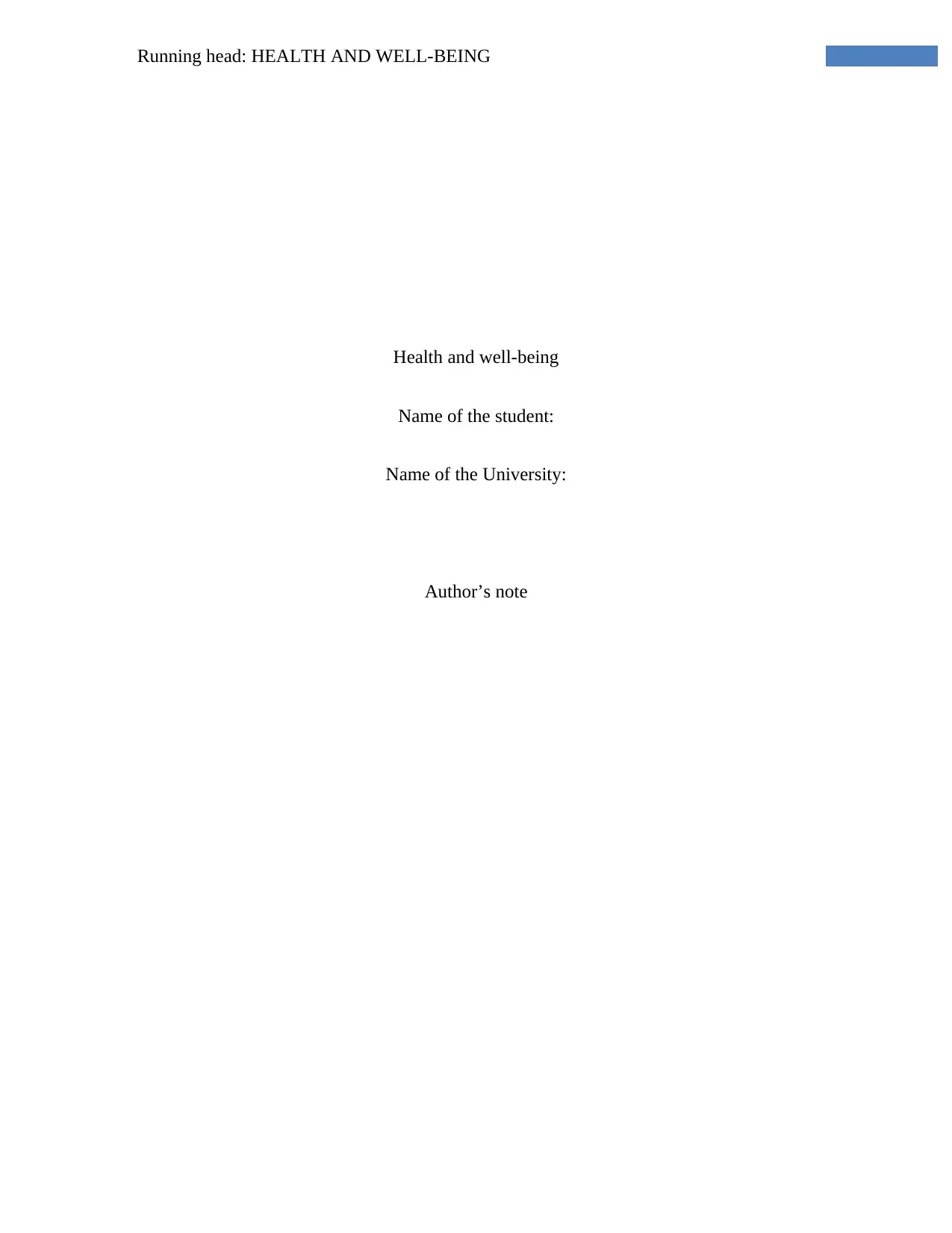
Running head: HEALTH AND WELL-BEING
Health and well-being
Name of the student:
Name of the University:
Author’s note
Health and well-being
Name of the student:
Name of the University:
Author’s note
Paraphrase This Document
Need a fresh take? Get an instant paraphrase of this document with our AI Paraphraser
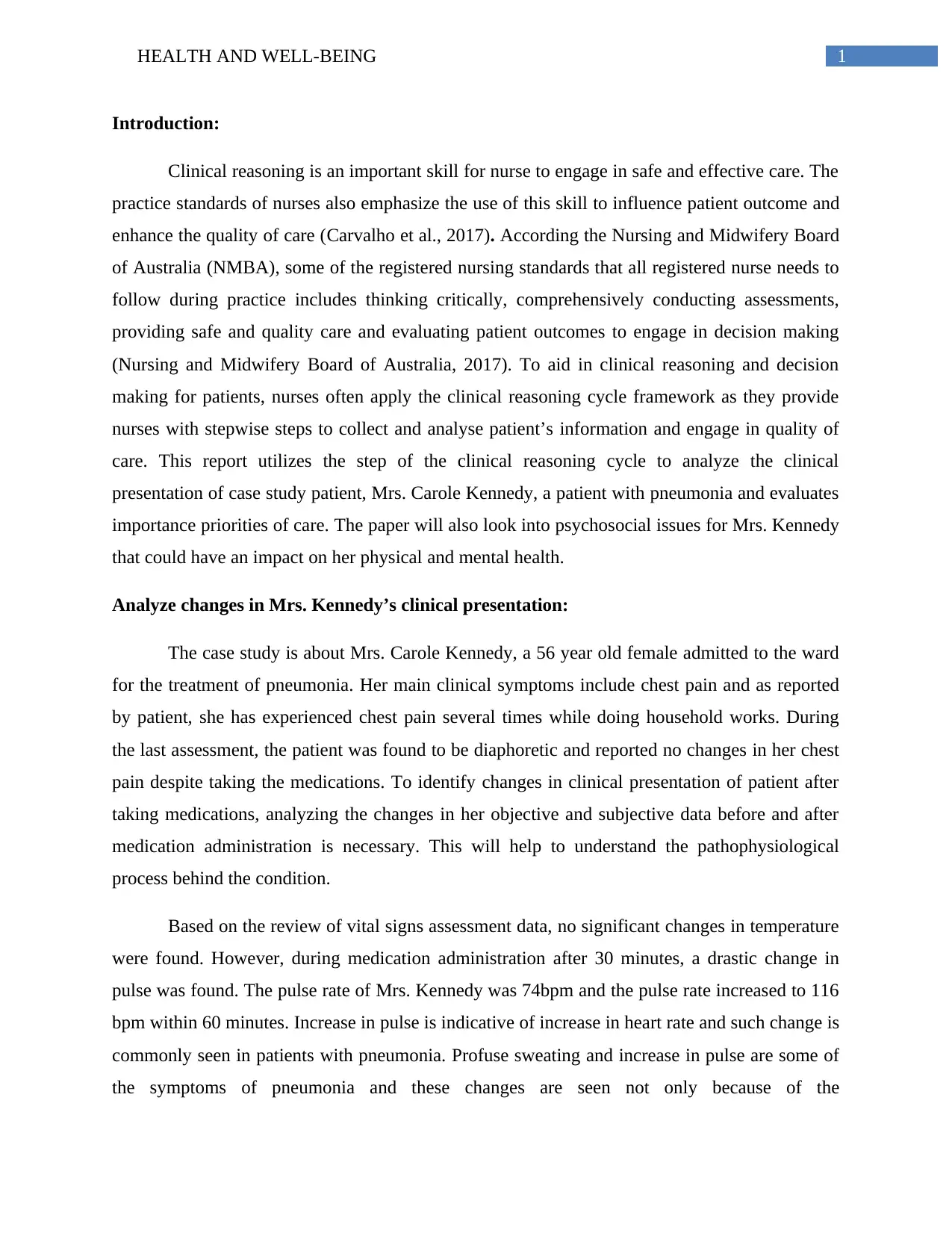
1HEALTH AND WELL-BEING
Introduction:
Clinical reasoning is an important skill for nurse to engage in safe and effective care. The
practice standards of nurses also emphasize the use of this skill to influence patient outcome and
enhance the quality of care (Carvalho et al., 2017). According the Nursing and Midwifery Board
of Australia (NMBA), some of the registered nursing standards that all registered nurse needs to
follow during practice includes thinking critically, comprehensively conducting assessments,
providing safe and quality care and evaluating patient outcomes to engage in decision making
(Nursing and Midwifery Board of Australia, 2017). To aid in clinical reasoning and decision
making for patients, nurses often apply the clinical reasoning cycle framework as they provide
nurses with stepwise steps to collect and analyse patient’s information and engage in quality of
care. This report utilizes the step of the clinical reasoning cycle to analyze the clinical
presentation of case study patient, Mrs. Carole Kennedy, a patient with pneumonia and evaluates
importance priorities of care. The paper will also look into psychosocial issues for Mrs. Kennedy
that could have an impact on her physical and mental health.
Analyze changes in Mrs. Kennedy’s clinical presentation:
The case study is about Mrs. Carole Kennedy, a 56 year old female admitted to the ward
for the treatment of pneumonia. Her main clinical symptoms include chest pain and as reported
by patient, she has experienced chest pain several times while doing household works. During
the last assessment, the patient was found to be diaphoretic and reported no changes in her chest
pain despite taking the medications. To identify changes in clinical presentation of patient after
taking medications, analyzing the changes in her objective and subjective data before and after
medication administration is necessary. This will help to understand the pathophysiological
process behind the condition.
Based on the review of vital signs assessment data, no significant changes in temperature
were found. However, during medication administration after 30 minutes, a drastic change in
pulse was found. The pulse rate of Mrs. Kennedy was 74bpm and the pulse rate increased to 116
bpm within 60 minutes. Increase in pulse is indicative of increase in heart rate and such change is
commonly seen in patients with pneumonia. Profuse sweating and increase in pulse are some of
the symptoms of pneumonia and these changes are seen not only because of the
Introduction:
Clinical reasoning is an important skill for nurse to engage in safe and effective care. The
practice standards of nurses also emphasize the use of this skill to influence patient outcome and
enhance the quality of care (Carvalho et al., 2017). According the Nursing and Midwifery Board
of Australia (NMBA), some of the registered nursing standards that all registered nurse needs to
follow during practice includes thinking critically, comprehensively conducting assessments,
providing safe and quality care and evaluating patient outcomes to engage in decision making
(Nursing and Midwifery Board of Australia, 2017). To aid in clinical reasoning and decision
making for patients, nurses often apply the clinical reasoning cycle framework as they provide
nurses with stepwise steps to collect and analyse patient’s information and engage in quality of
care. This report utilizes the step of the clinical reasoning cycle to analyze the clinical
presentation of case study patient, Mrs. Carole Kennedy, a patient with pneumonia and evaluates
importance priorities of care. The paper will also look into psychosocial issues for Mrs. Kennedy
that could have an impact on her physical and mental health.
Analyze changes in Mrs. Kennedy’s clinical presentation:
The case study is about Mrs. Carole Kennedy, a 56 year old female admitted to the ward
for the treatment of pneumonia. Her main clinical symptoms include chest pain and as reported
by patient, she has experienced chest pain several times while doing household works. During
the last assessment, the patient was found to be diaphoretic and reported no changes in her chest
pain despite taking the medications. To identify changes in clinical presentation of patient after
taking medications, analyzing the changes in her objective and subjective data before and after
medication administration is necessary. This will help to understand the pathophysiological
process behind the condition.
Based on the review of vital signs assessment data, no significant changes in temperature
were found. However, during medication administration after 30 minutes, a drastic change in
pulse was found. The pulse rate of Mrs. Kennedy was 74bpm and the pulse rate increased to 116
bpm within 60 minutes. Increase in pulse is indicative of increase in heart rate and such change is
commonly seen in patients with pneumonia. Profuse sweating and increase in pulse are some of
the symptoms of pneumonia and these changes are seen not only because of the
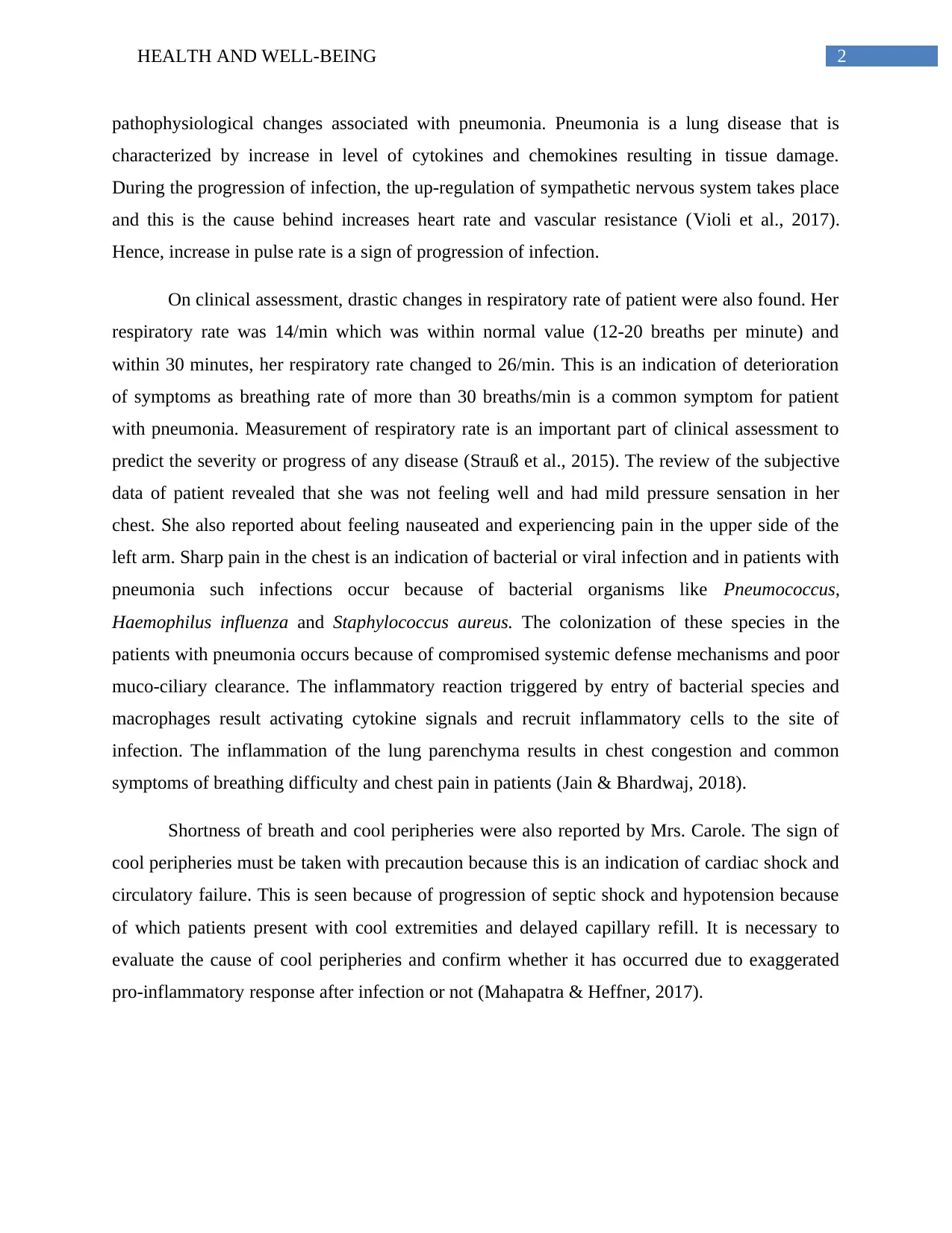
2HEALTH AND WELL-BEING
pathophysiological changes associated with pneumonia. Pneumonia is a lung disease that is
characterized by increase in level of cytokines and chemokines resulting in tissue damage.
During the progression of infection, the up-regulation of sympathetic nervous system takes place
and this is the cause behind increases heart rate and vascular resistance (Violi et al., 2017).
Hence, increase in pulse rate is a sign of progression of infection.
On clinical assessment, drastic changes in respiratory rate of patient were also found. Her
respiratory rate was 14/min which was within normal value (12-20 breaths per minute) and
within 30 minutes, her respiratory rate changed to 26/min. This is an indication of deterioration
of symptoms as breathing rate of more than 30 breaths/min is a common symptom for patient
with pneumonia. Measurement of respiratory rate is an important part of clinical assessment to
predict the severity or progress of any disease (Strauß et al., 2015). The review of the subjective
data of patient revealed that she was not feeling well and had mild pressure sensation in her
chest. She also reported about feeling nauseated and experiencing pain in the upper side of the
left arm. Sharp pain in the chest is an indication of bacterial or viral infection and in patients with
pneumonia such infections occur because of bacterial organisms like Pneumococcus,
Haemophilus influenza and Staphylococcus aureus. The colonization of these species in the
patients with pneumonia occurs because of compromised systemic defense mechanisms and poor
muco-ciliary clearance. The inflammatory reaction triggered by entry of bacterial species and
macrophages result activating cytokine signals and recruit inflammatory cells to the site of
infection. The inflammation of the lung parenchyma results in chest congestion and common
symptoms of breathing difficulty and chest pain in patients (Jain & Bhardwaj, 2018).
Shortness of breath and cool peripheries were also reported by Mrs. Carole. The sign of
cool peripheries must be taken with precaution because this is an indication of cardiac shock and
circulatory failure. This is seen because of progression of septic shock and hypotension because
of which patients present with cool extremities and delayed capillary refill. It is necessary to
evaluate the cause of cool peripheries and confirm whether it has occurred due to exaggerated
pro-inflammatory response after infection or not (Mahapatra & Heffner, 2017).
pathophysiological changes associated with pneumonia. Pneumonia is a lung disease that is
characterized by increase in level of cytokines and chemokines resulting in tissue damage.
During the progression of infection, the up-regulation of sympathetic nervous system takes place
and this is the cause behind increases heart rate and vascular resistance (Violi et al., 2017).
Hence, increase in pulse rate is a sign of progression of infection.
On clinical assessment, drastic changes in respiratory rate of patient were also found. Her
respiratory rate was 14/min which was within normal value (12-20 breaths per minute) and
within 30 minutes, her respiratory rate changed to 26/min. This is an indication of deterioration
of symptoms as breathing rate of more than 30 breaths/min is a common symptom for patient
with pneumonia. Measurement of respiratory rate is an important part of clinical assessment to
predict the severity or progress of any disease (Strauß et al., 2015). The review of the subjective
data of patient revealed that she was not feeling well and had mild pressure sensation in her
chest. She also reported about feeling nauseated and experiencing pain in the upper side of the
left arm. Sharp pain in the chest is an indication of bacterial or viral infection and in patients with
pneumonia such infections occur because of bacterial organisms like Pneumococcus,
Haemophilus influenza and Staphylococcus aureus. The colonization of these species in the
patients with pneumonia occurs because of compromised systemic defense mechanisms and poor
muco-ciliary clearance. The inflammatory reaction triggered by entry of bacterial species and
macrophages result activating cytokine signals and recruit inflammatory cells to the site of
infection. The inflammation of the lung parenchyma results in chest congestion and common
symptoms of breathing difficulty and chest pain in patients (Jain & Bhardwaj, 2018).
Shortness of breath and cool peripheries were also reported by Mrs. Carole. The sign of
cool peripheries must be taken with precaution because this is an indication of cardiac shock and
circulatory failure. This is seen because of progression of septic shock and hypotension because
of which patients present with cool extremities and delayed capillary refill. It is necessary to
evaluate the cause of cool peripheries and confirm whether it has occurred due to exaggerated
pro-inflammatory response after infection or not (Mahapatra & Heffner, 2017).
⊘ This is a preview!⊘
Do you want full access?
Subscribe today to unlock all pages.

Trusted by 1+ million students worldwide
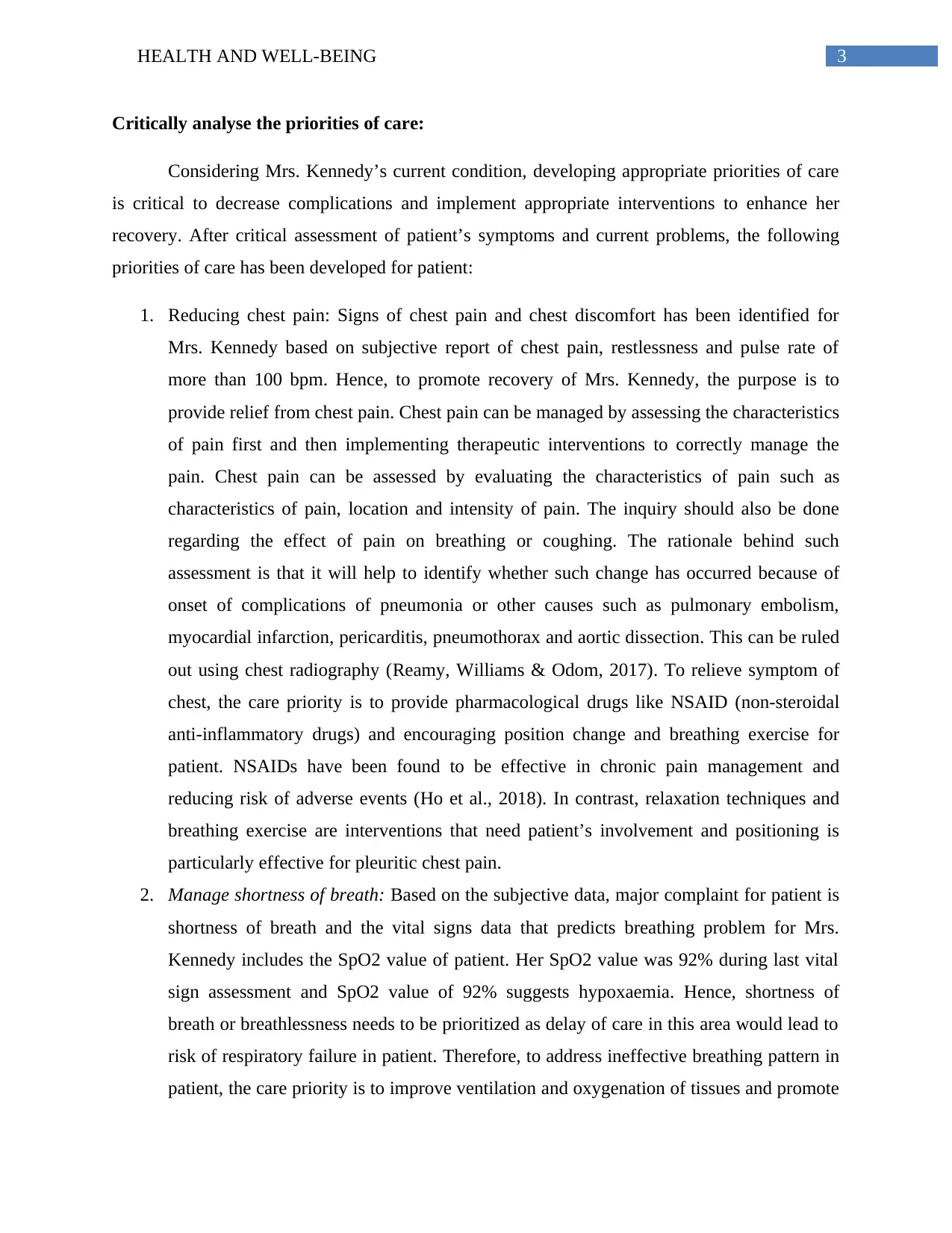
3HEALTH AND WELL-BEING
Critically analyse the priorities of care:
Considering Mrs. Kennedy’s current condition, developing appropriate priorities of care
is critical to decrease complications and implement appropriate interventions to enhance her
recovery. After critical assessment of patient’s symptoms and current problems, the following
priorities of care has been developed for patient:
1. Reducing chest pain: Signs of chest pain and chest discomfort has been identified for
Mrs. Kennedy based on subjective report of chest pain, restlessness and pulse rate of
more than 100 bpm. Hence, to promote recovery of Mrs. Kennedy, the purpose is to
provide relief from chest pain. Chest pain can be managed by assessing the characteristics
of pain first and then implementing therapeutic interventions to correctly manage the
pain. Chest pain can be assessed by evaluating the characteristics of pain such as
characteristics of pain, location and intensity of pain. The inquiry should also be done
regarding the effect of pain on breathing or coughing. The rationale behind such
assessment is that it will help to identify whether such change has occurred because of
onset of complications of pneumonia or other causes such as pulmonary embolism,
myocardial infarction, pericarditis, pneumothorax and aortic dissection. This can be ruled
out using chest radiography (Reamy, Williams & Odom, 2017). To relieve symptom of
chest, the care priority is to provide pharmacological drugs like NSAID (non-steroidal
anti-inflammatory drugs) and encouraging position change and breathing exercise for
patient. NSAIDs have been found to be effective in chronic pain management and
reducing risk of adverse events (Ho et al., 2018). In contrast, relaxation techniques and
breathing exercise are interventions that need patient’s involvement and positioning is
particularly effective for pleuritic chest pain.
2. Manage shortness of breath: Based on the subjective data, major complaint for patient is
shortness of breath and the vital signs data that predicts breathing problem for Mrs.
Kennedy includes the SpO2 value of patient. Her SpO2 value was 92% during last vital
sign assessment and SpO2 value of 92% suggests hypoxaemia. Hence, shortness of
breath or breathlessness needs to be prioritized as delay of care in this area would lead to
risk of respiratory failure in patient. Therefore, to address ineffective breathing pattern in
patient, the care priority is to improve ventilation and oxygenation of tissues and promote
Critically analyse the priorities of care:
Considering Mrs. Kennedy’s current condition, developing appropriate priorities of care
is critical to decrease complications and implement appropriate interventions to enhance her
recovery. After critical assessment of patient’s symptoms and current problems, the following
priorities of care has been developed for patient:
1. Reducing chest pain: Signs of chest pain and chest discomfort has been identified for
Mrs. Kennedy based on subjective report of chest pain, restlessness and pulse rate of
more than 100 bpm. Hence, to promote recovery of Mrs. Kennedy, the purpose is to
provide relief from chest pain. Chest pain can be managed by assessing the characteristics
of pain first and then implementing therapeutic interventions to correctly manage the
pain. Chest pain can be assessed by evaluating the characteristics of pain such as
characteristics of pain, location and intensity of pain. The inquiry should also be done
regarding the effect of pain on breathing or coughing. The rationale behind such
assessment is that it will help to identify whether such change has occurred because of
onset of complications of pneumonia or other causes such as pulmonary embolism,
myocardial infarction, pericarditis, pneumothorax and aortic dissection. This can be ruled
out using chest radiography (Reamy, Williams & Odom, 2017). To relieve symptom of
chest, the care priority is to provide pharmacological drugs like NSAID (non-steroidal
anti-inflammatory drugs) and encouraging position change and breathing exercise for
patient. NSAIDs have been found to be effective in chronic pain management and
reducing risk of adverse events (Ho et al., 2018). In contrast, relaxation techniques and
breathing exercise are interventions that need patient’s involvement and positioning is
particularly effective for pleuritic chest pain.
2. Manage shortness of breath: Based on the subjective data, major complaint for patient is
shortness of breath and the vital signs data that predicts breathing problem for Mrs.
Kennedy includes the SpO2 value of patient. Her SpO2 value was 92% during last vital
sign assessment and SpO2 value of 92% suggests hypoxaemia. Hence, shortness of
breath or breathlessness needs to be prioritized as delay of care in this area would lead to
risk of respiratory failure in patient. Therefore, to address ineffective breathing pattern in
patient, the care priority is to improve ventilation and oxygenation of tissues and promote
Paraphrase This Document
Need a fresh take? Get an instant paraphrase of this document with our AI Paraphraser
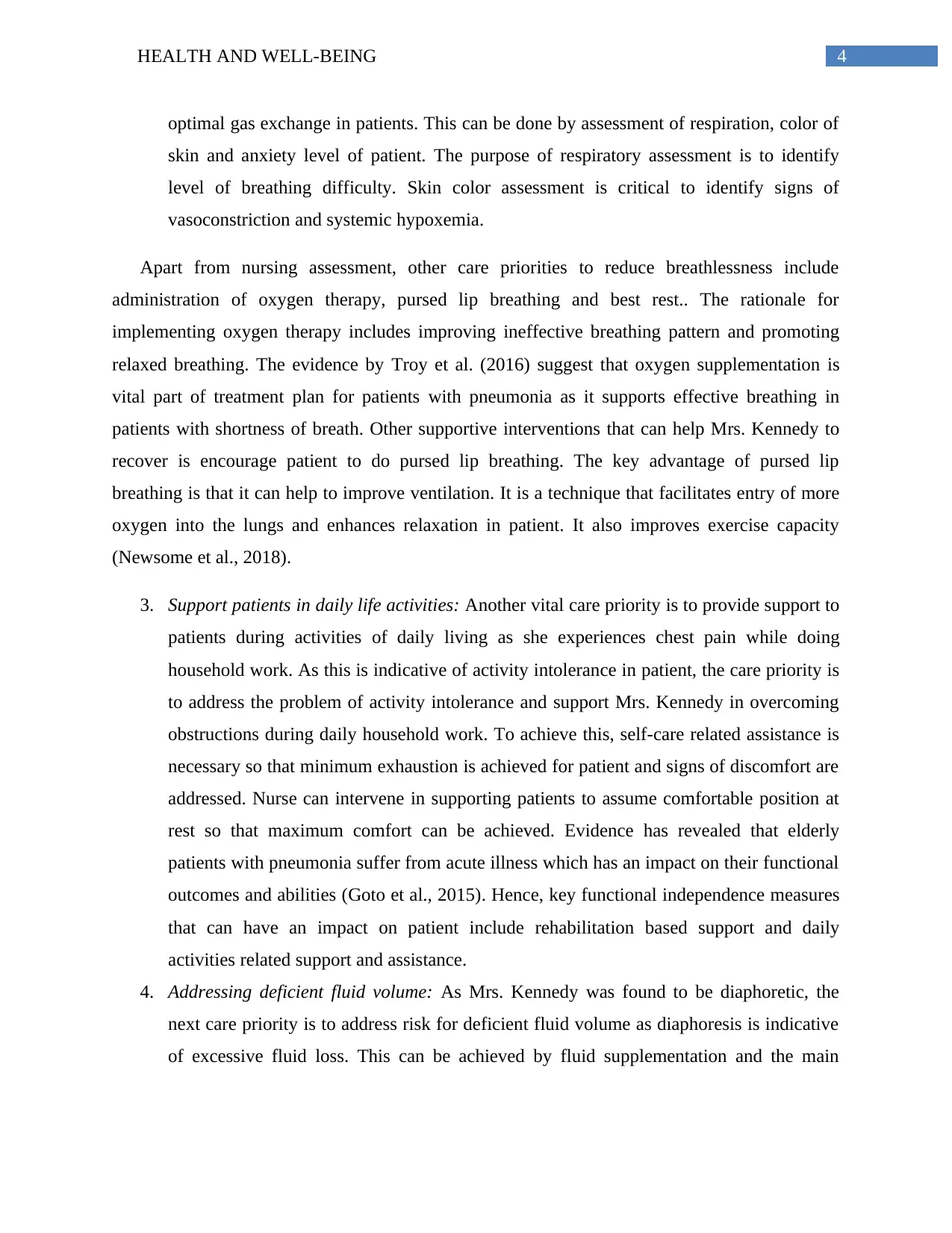
4HEALTH AND WELL-BEING
optimal gas exchange in patients. This can be done by assessment of respiration, color of
skin and anxiety level of patient. The purpose of respiratory assessment is to identify
level of breathing difficulty. Skin color assessment is critical to identify signs of
vasoconstriction and systemic hypoxemia.
Apart from nursing assessment, other care priorities to reduce breathlessness include
administration of oxygen therapy, pursed lip breathing and best rest.. The rationale for
implementing oxygen therapy includes improving ineffective breathing pattern and promoting
relaxed breathing. The evidence by Troy et al. (2016) suggest that oxygen supplementation is
vital part of treatment plan for patients with pneumonia as it supports effective breathing in
patients with shortness of breath. Other supportive interventions that can help Mrs. Kennedy to
recover is encourage patient to do pursed lip breathing. The key advantage of pursed lip
breathing is that it can help to improve ventilation. It is a technique that facilitates entry of more
oxygen into the lungs and enhances relaxation in patient. It also improves exercise capacity
(Newsome et al., 2018).
3. Support patients in daily life activities: Another vital care priority is to provide support to
patients during activities of daily living as she experiences chest pain while doing
household work. As this is indicative of activity intolerance in patient, the care priority is
to address the problem of activity intolerance and support Mrs. Kennedy in overcoming
obstructions during daily household work. To achieve this, self-care related assistance is
necessary so that minimum exhaustion is achieved for patient and signs of discomfort are
addressed. Nurse can intervene in supporting patients to assume comfortable position at
rest so that maximum comfort can be achieved. Evidence has revealed that elderly
patients with pneumonia suffer from acute illness which has an impact on their functional
outcomes and abilities (Goto et al., 2015). Hence, key functional independence measures
that can have an impact on patient include rehabilitation based support and daily
activities related support and assistance.
4. Addressing deficient fluid volume: As Mrs. Kennedy was found to be diaphoretic, the
next care priority is to address risk for deficient fluid volume as diaphoresis is indicative
of excessive fluid loss. This can be achieved by fluid supplementation and the main
optimal gas exchange in patients. This can be done by assessment of respiration, color of
skin and anxiety level of patient. The purpose of respiratory assessment is to identify
level of breathing difficulty. Skin color assessment is critical to identify signs of
vasoconstriction and systemic hypoxemia.
Apart from nursing assessment, other care priorities to reduce breathlessness include
administration of oxygen therapy, pursed lip breathing and best rest.. The rationale for
implementing oxygen therapy includes improving ineffective breathing pattern and promoting
relaxed breathing. The evidence by Troy et al. (2016) suggest that oxygen supplementation is
vital part of treatment plan for patients with pneumonia as it supports effective breathing in
patients with shortness of breath. Other supportive interventions that can help Mrs. Kennedy to
recover is encourage patient to do pursed lip breathing. The key advantage of pursed lip
breathing is that it can help to improve ventilation. It is a technique that facilitates entry of more
oxygen into the lungs and enhances relaxation in patient. It also improves exercise capacity
(Newsome et al., 2018).
3. Support patients in daily life activities: Another vital care priority is to provide support to
patients during activities of daily living as she experiences chest pain while doing
household work. As this is indicative of activity intolerance in patient, the care priority is
to address the problem of activity intolerance and support Mrs. Kennedy in overcoming
obstructions during daily household work. To achieve this, self-care related assistance is
necessary so that minimum exhaustion is achieved for patient and signs of discomfort are
addressed. Nurse can intervene in supporting patients to assume comfortable position at
rest so that maximum comfort can be achieved. Evidence has revealed that elderly
patients with pneumonia suffer from acute illness which has an impact on their functional
outcomes and abilities (Goto et al., 2015). Hence, key functional independence measures
that can have an impact on patient include rehabilitation based support and daily
activities related support and assistance.
4. Addressing deficient fluid volume: As Mrs. Kennedy was found to be diaphoretic, the
next care priority is to address risk for deficient fluid volume as diaphoresis is indicative
of excessive fluid loss. This can be achieved by fluid supplementation and the main
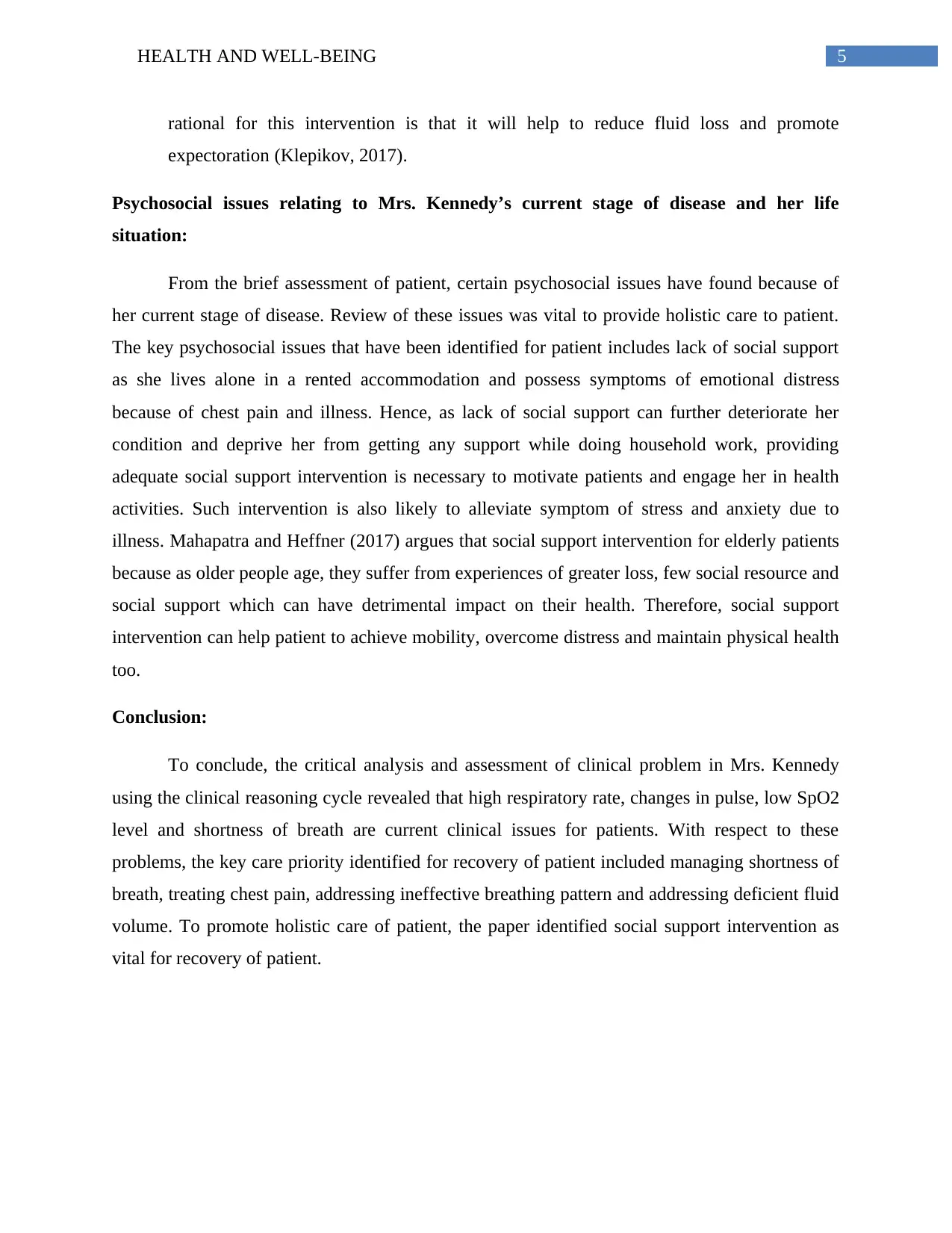
5HEALTH AND WELL-BEING
rational for this intervention is that it will help to reduce fluid loss and promote
expectoration (Klepikov, 2017).
Psychosocial issues relating to Mrs. Kennedy’s current stage of disease and her life
situation:
From the brief assessment of patient, certain psychosocial issues have found because of
her current stage of disease. Review of these issues was vital to provide holistic care to patient.
The key psychosocial issues that have been identified for patient includes lack of social support
as she lives alone in a rented accommodation and possess symptoms of emotional distress
because of chest pain and illness. Hence, as lack of social support can further deteriorate her
condition and deprive her from getting any support while doing household work, providing
adequate social support intervention is necessary to motivate patients and engage her in health
activities. Such intervention is also likely to alleviate symptom of stress and anxiety due to
illness. Mahapatra and Heffner (2017) argues that social support intervention for elderly patients
because as older people age, they suffer from experiences of greater loss, few social resource and
social support which can have detrimental impact on their health. Therefore, social support
intervention can help patient to achieve mobility, overcome distress and maintain physical health
too.
Conclusion:
To conclude, the critical analysis and assessment of clinical problem in Mrs. Kennedy
using the clinical reasoning cycle revealed that high respiratory rate, changes in pulse, low SpO2
level and shortness of breath are current clinical issues for patients. With respect to these
problems, the key care priority identified for recovery of patient included managing shortness of
breath, treating chest pain, addressing ineffective breathing pattern and addressing deficient fluid
volume. To promote holistic care of patient, the paper identified social support intervention as
vital for recovery of patient.
rational for this intervention is that it will help to reduce fluid loss and promote
expectoration (Klepikov, 2017).
Psychosocial issues relating to Mrs. Kennedy’s current stage of disease and her life
situation:
From the brief assessment of patient, certain psychosocial issues have found because of
her current stage of disease. Review of these issues was vital to provide holistic care to patient.
The key psychosocial issues that have been identified for patient includes lack of social support
as she lives alone in a rented accommodation and possess symptoms of emotional distress
because of chest pain and illness. Hence, as lack of social support can further deteriorate her
condition and deprive her from getting any support while doing household work, providing
adequate social support intervention is necessary to motivate patients and engage her in health
activities. Such intervention is also likely to alleviate symptom of stress and anxiety due to
illness. Mahapatra and Heffner (2017) argues that social support intervention for elderly patients
because as older people age, they suffer from experiences of greater loss, few social resource and
social support which can have detrimental impact on their health. Therefore, social support
intervention can help patient to achieve mobility, overcome distress and maintain physical health
too.
Conclusion:
To conclude, the critical analysis and assessment of clinical problem in Mrs. Kennedy
using the clinical reasoning cycle revealed that high respiratory rate, changes in pulse, low SpO2
level and shortness of breath are current clinical issues for patients. With respect to these
problems, the key care priority identified for recovery of patient included managing shortness of
breath, treating chest pain, addressing ineffective breathing pattern and addressing deficient fluid
volume. To promote holistic care of patient, the paper identified social support intervention as
vital for recovery of patient.
⊘ This is a preview!⊘
Do you want full access?
Subscribe today to unlock all pages.

Trusted by 1+ million students worldwide
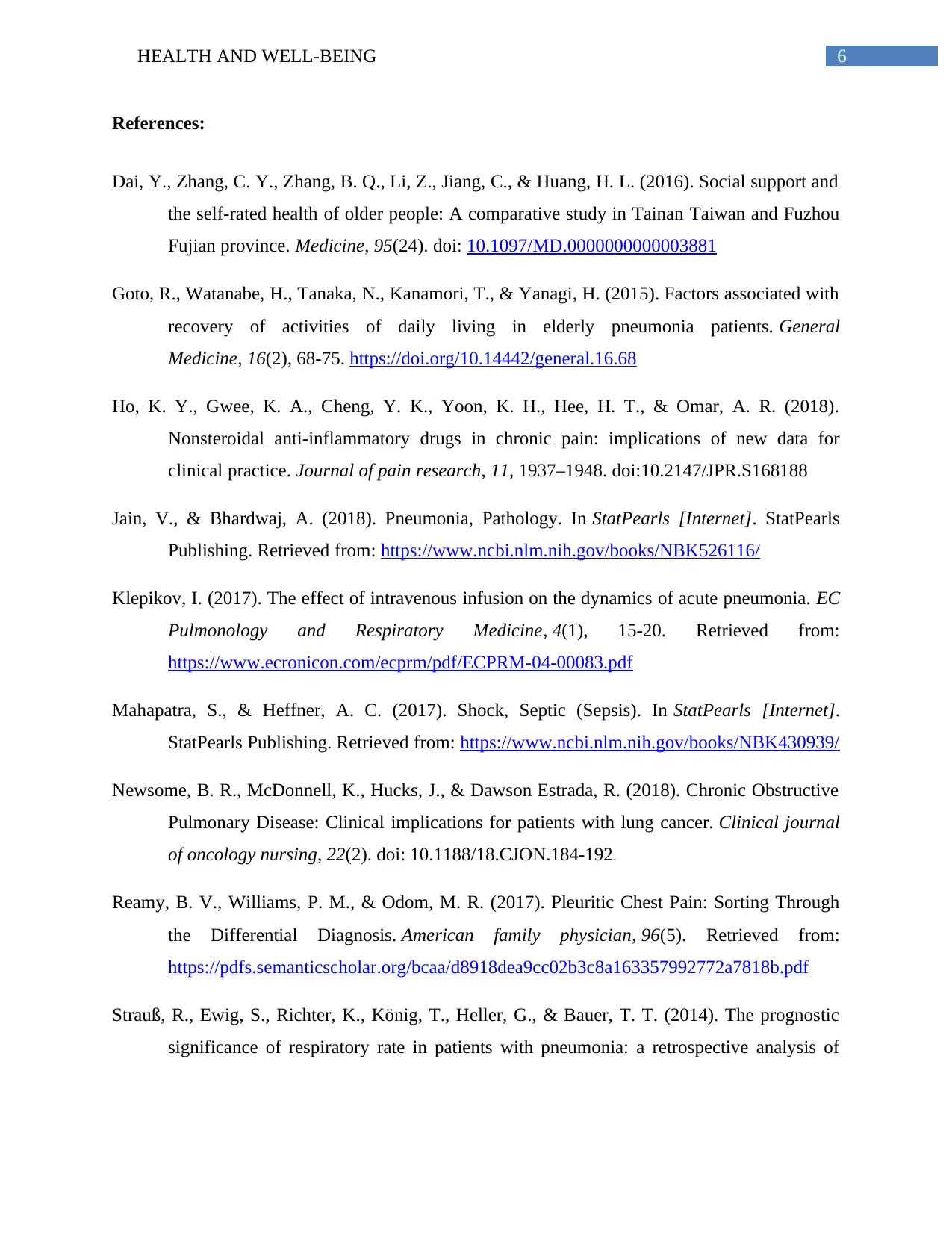
6HEALTH AND WELL-BEING
References:
Dai, Y., Zhang, C. Y., Zhang, B. Q., Li, Z., Jiang, C., & Huang, H. L. (2016). Social support and
the self-rated health of older people: A comparative study in Tainan Taiwan and Fuzhou
Fujian province. Medicine, 95(24). doi: 10.1097/MD.0000000000003881
Goto, R., Watanabe, H., Tanaka, N., Kanamori, T., & Yanagi, H. (2015). Factors associated with
recovery of activities of daily living in elderly pneumonia patients. General
Medicine, 16(2), 68-75. https://doi.org/10.14442/general.16.68
Ho, K. Y., Gwee, K. A., Cheng, Y. K., Yoon, K. H., Hee, H. T., & Omar, A. R. (2018).
Nonsteroidal anti-inflammatory drugs in chronic pain: implications of new data for
clinical practice. Journal of pain research, 11, 1937–1948. doi:10.2147/JPR.S168188
Jain, V., & Bhardwaj, A. (2018). Pneumonia, Pathology. In StatPearls [Internet]. StatPearls
Publishing. Retrieved from: https://www.ncbi.nlm.nih.gov/books/NBK526116/
Klepikov, I. (2017). The effect of intravenous infusion on the dynamics of acute pneumonia. EC
Pulmonology and Respiratory Medicine, 4(1), 15-20. Retrieved from:
https://www.ecronicon.com/ecprm/pdf/ECPRM-04-00083.pdf
Mahapatra, S., & Heffner, A. C. (2017). Shock, Septic (Sepsis). In StatPearls [Internet].
StatPearls Publishing. Retrieved from: https://www.ncbi.nlm.nih.gov/books/NBK430939/
Newsome, B. R., McDonnell, K., Hucks, J., & Dawson Estrada, R. (2018). Chronic Obstructive
Pulmonary Disease: Clinical implications for patients with lung cancer. Clinical journal
of oncology nursing, 22(2). doi: 10.1188/18.CJON.184-192.
Reamy, B. V., Williams, P. M., & Odom, M. R. (2017). Pleuritic Chest Pain: Sorting Through
the Differential Diagnosis. American family physician, 96(5). Retrieved from:
https://pdfs.semanticscholar.org/bcaa/d8918dea9cc02b3c8a163357992772a7818b.pdf
Strauß, R., Ewig, S., Richter, K., König, T., Heller, G., & Bauer, T. T. (2014). The prognostic
significance of respiratory rate in patients with pneumonia: a retrospective analysis of
References:
Dai, Y., Zhang, C. Y., Zhang, B. Q., Li, Z., Jiang, C., & Huang, H. L. (2016). Social support and
the self-rated health of older people: A comparative study in Tainan Taiwan and Fuzhou
Fujian province. Medicine, 95(24). doi: 10.1097/MD.0000000000003881
Goto, R., Watanabe, H., Tanaka, N., Kanamori, T., & Yanagi, H. (2015). Factors associated with
recovery of activities of daily living in elderly pneumonia patients. General
Medicine, 16(2), 68-75. https://doi.org/10.14442/general.16.68
Ho, K. Y., Gwee, K. A., Cheng, Y. K., Yoon, K. H., Hee, H. T., & Omar, A. R. (2018).
Nonsteroidal anti-inflammatory drugs in chronic pain: implications of new data for
clinical practice. Journal of pain research, 11, 1937–1948. doi:10.2147/JPR.S168188
Jain, V., & Bhardwaj, A. (2018). Pneumonia, Pathology. In StatPearls [Internet]. StatPearls
Publishing. Retrieved from: https://www.ncbi.nlm.nih.gov/books/NBK526116/
Klepikov, I. (2017). The effect of intravenous infusion on the dynamics of acute pneumonia. EC
Pulmonology and Respiratory Medicine, 4(1), 15-20. Retrieved from:
https://www.ecronicon.com/ecprm/pdf/ECPRM-04-00083.pdf
Mahapatra, S., & Heffner, A. C. (2017). Shock, Septic (Sepsis). In StatPearls [Internet].
StatPearls Publishing. Retrieved from: https://www.ncbi.nlm.nih.gov/books/NBK430939/
Newsome, B. R., McDonnell, K., Hucks, J., & Dawson Estrada, R. (2018). Chronic Obstructive
Pulmonary Disease: Clinical implications for patients with lung cancer. Clinical journal
of oncology nursing, 22(2). doi: 10.1188/18.CJON.184-192.
Reamy, B. V., Williams, P. M., & Odom, M. R. (2017). Pleuritic Chest Pain: Sorting Through
the Differential Diagnosis. American family physician, 96(5). Retrieved from:
https://pdfs.semanticscholar.org/bcaa/d8918dea9cc02b3c8a163357992772a7818b.pdf
Strauß, R., Ewig, S., Richter, K., König, T., Heller, G., & Bauer, T. T. (2014). The prognostic
significance of respiratory rate in patients with pneumonia: a retrospective analysis of
Paraphrase This Document
Need a fresh take? Get an instant paraphrase of this document with our AI Paraphraser
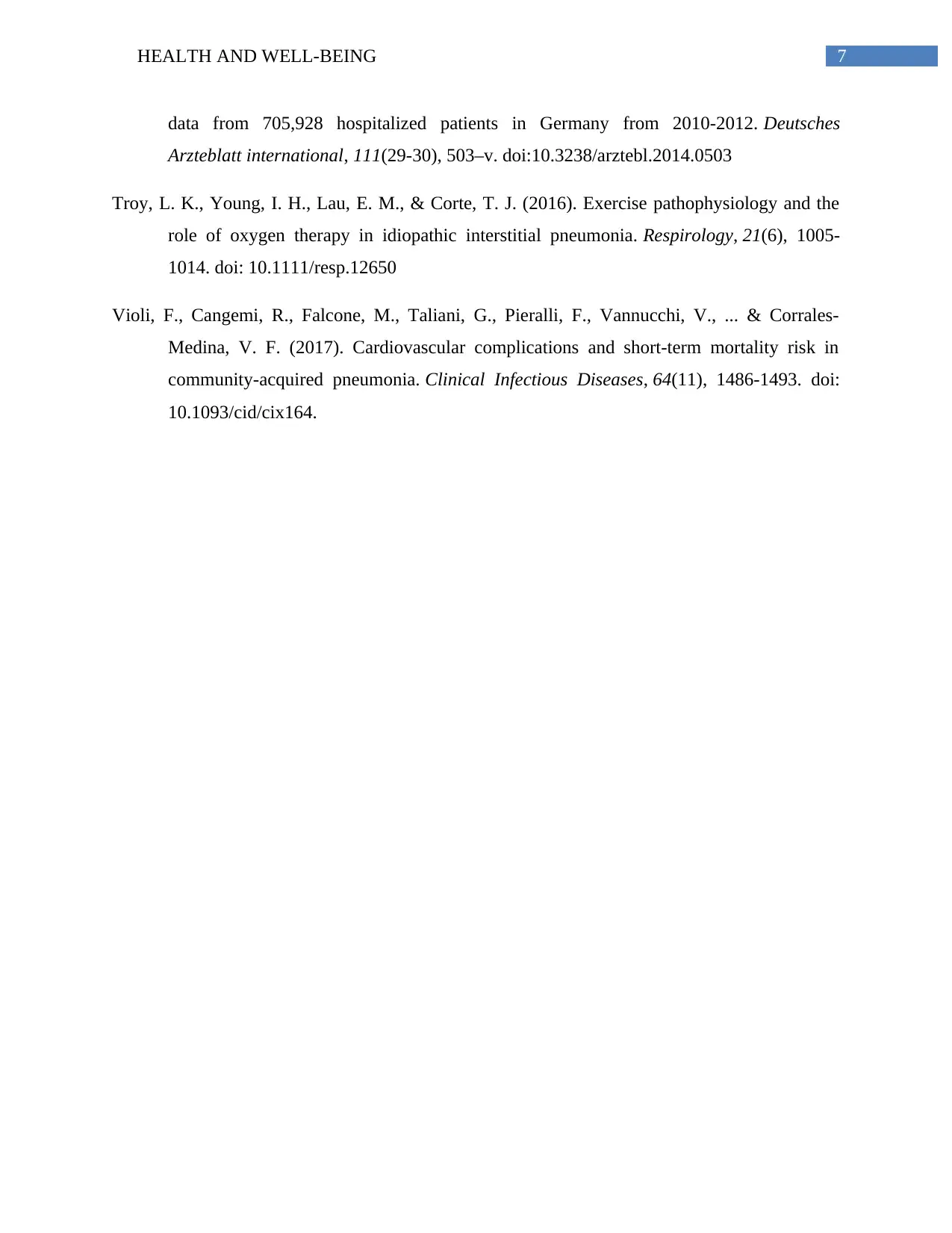
7HEALTH AND WELL-BEING
data from 705,928 hospitalized patients in Germany from 2010-2012. Deutsches
Arzteblatt international, 111(29-30), 503–v. doi:10.3238/arztebl.2014.0503
Troy, L. K., Young, I. H., Lau, E. M., & Corte, T. J. (2016). Exercise pathophysiology and the
role of oxygen therapy in idiopathic interstitial pneumonia. Respirology, 21(6), 1005-
1014. doi: 10.1111/resp.12650
Violi, F., Cangemi, R., Falcone, M., Taliani, G., Pieralli, F., Vannucchi, V., ... & Corrales-
Medina, V. F. (2017). Cardiovascular complications and short-term mortality risk in
community-acquired pneumonia. Clinical Infectious Diseases, 64(11), 1486-1493. doi:
10.1093/cid/cix164.
data from 705,928 hospitalized patients in Germany from 2010-2012. Deutsches
Arzteblatt international, 111(29-30), 503–v. doi:10.3238/arztebl.2014.0503
Troy, L. K., Young, I. H., Lau, E. M., & Corte, T. J. (2016). Exercise pathophysiology and the
role of oxygen therapy in idiopathic interstitial pneumonia. Respirology, 21(6), 1005-
1014. doi: 10.1111/resp.12650
Violi, F., Cangemi, R., Falcone, M., Taliani, G., Pieralli, F., Vannucchi, V., ... & Corrales-
Medina, V. F. (2017). Cardiovascular complications and short-term mortality risk in
community-acquired pneumonia. Clinical Infectious Diseases, 64(11), 1486-1493. doi:
10.1093/cid/cix164.
1 out of 8
Related Documents
Your All-in-One AI-Powered Toolkit for Academic Success.
+13062052269
info@desklib.com
Available 24*7 on WhatsApp / Email
![[object Object]](/_next/static/media/star-bottom.7253800d.svg)
Unlock your academic potential
Copyright © 2020–2025 A2Z Services. All Rights Reserved. Developed and managed by ZUCOL.





